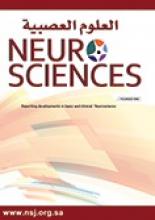Research ArticleOriginal Article
Open Access
Functional recovery differences after stroke rehabilitation in patients with uni- or bilateral hemiparesis
Saad M. Bindawas, Hussam M. Mawajdeh, Vishal S. Vennu and Hisham M. Alhaidary
Neurosciences Journal July 2017, 22 (3) 186-191; DOI: https://doi.org/10.17712/nsj.2017.3.20170010
Saad M. Bindawas
From the Department of Rehabilitation Sciences (Bindawas, Vennu), King Saud University, and Rehabilitation Hospital (Mawajdeh, Alhaidary), King Fahad Medical City, Riyadh, Kingdom of Saudi Arabia
PhD, PTHussam M. Mawajdeh
From the Department of Rehabilitation Sciences (Bindawas, Vennu), King Saud University, and Rehabilitation Hospital (Mawajdeh, Alhaidary), King Fahad Medical City, Riyadh, Kingdom of Saudi Arabia
OTRVishal S. Vennu
From the Department of Rehabilitation Sciences (Bindawas, Vennu), King Saud University, and Rehabilitation Hospital (Mawajdeh, Alhaidary), King Fahad Medical City, Riyadh, Kingdom of Saudi Arabia
MSc, BScHisham M. Alhaidary
From the Department of Rehabilitation Sciences (Bindawas, Vennu), King Saud University, and Rehabilitation Hospital (Mawajdeh, Alhaidary), King Fahad Medical City, Riyadh, Kingdom of Saudi Arabia
PT, DPT
References
- ↵
- Wist S,
- Clivaz J,
- Sattelmayer M
- ↵
- Go AS,
- Mozaffarian D,
- Roger VL,
- Benjamin EJ,
- Berry JD,
- Borden WB,
- et al.
- ↵
- Schaefer SY,
- Mutha PK,
- Haaland KY,
- Sainburg RL
- ↵
- Marx JA,
- Rosen P
- ↵
- Enderby P,
- Pandyan A,
- Bowen A,
- Hearnden D,
- Ashburn A,
- Conroy P,
- et al.
- ↵
- Kandel ER,
- Schwartz JH,
- Jessell TM,
- Siegelbaum SA,
- Hudspeth AJ
- ↵
- Zhang J,
- Wei R,
- Chen Z,
- Luo B
- ↵
- Pappalardo A,
- Ciancio MR,
- Patti F
- ↵
- Gracies JM
- ↵
- Kunz WG,
- Sommer WH,
- Hohne C,
- Fabritius MP,
- Schuler F,
- Dorn F,
- et al.
- ↵
- Iso N,
- Ooso S,
- Yamamoto N,
- Moriuchi T,
- Sagari A,
- Iso F,
- et al.
- ↵
- Robert AA,
- Zamzami MM
- ↵
- Bindawas SM,
- Vennu VS
- ↵
- Alqahtani M,
- AlKhtaami A,
- AlGobain M,
- Aljohani N,
- Bin SA,
- AlShalati F,
- et al.
- ↵
- Vanbellingen T,
- Ottiger B,
- Pflugshaupt T,
- Mehrholz J,
- Bohlhalter S,
- Nef T,
- et al.
- ↵
- Kim HY
- ↵
- Fernandez-Lozano C,
- Gestal M,
- Munteanu CR,
- Dorado J,
- Pazos A
- ↵
- Delwiche LD,
- Slaughter SJ
- ↵
- Lopes PG,
- Lopes JA,
- Brito CM,
- Alfieri FM,
- Rizzo Battistella L
- ↵
- Knoflach M,
- Matosevic B,
- Rucker M,
- Furtner M,
- Mair A,
- Wille G,
- et al.
- ↵
- Abdul-sattar AB,
- Godab T
- ↵
- Zhu Z,
- Cui L,
- Yin M,
- Yu Y,
- Zhou X,
- Wang H,
- et al.
- ↵
- Sundseth A,
- Thommessen B,
- Ronning OM
- ↵
- Foley N,
- McClure JA,
- Meyer M,
- Salter K,
- Bureau Y,
- Teasell R
- ↵
- Stroke Unit Trialists'Collaboration
- Pollock A,
- Baer G,
- Campbell P,
- Choo PL,
- Forster A,
- Morris J,
- et al.
- ↵
- Bindawas SM,
- Mawajdeh H,
- Vennu V,
- Alhaidary H
- ↵
- Bindawas SM,
- Vennu V,
- Moftah E
In this issue
Functional recovery differences after stroke rehabilitation in patients with uni- or bilateral hemiparesis
Saad M. Bindawas, Hussam M. Mawajdeh, Vishal S. Vennu, Hisham M. Alhaidary
Neurosciences Journal Jul 2017, 22 (3) 186-191; DOI: 10.17712/nsj.2017.3.20170010
Jump to section
Related Articles
- No related articles found.
Cited By...
- No citing articles found.





